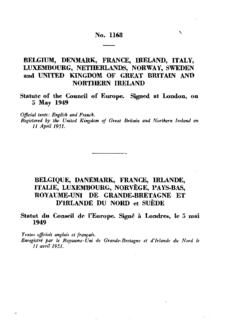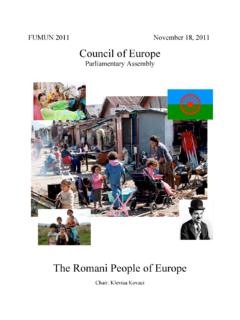Transcription of ‘The Interplay between Council of Europe, OSCE, EU and NATO’
1 Ugo CarusoInterplay between the Council of europe , OSCE, eu and nato This report was compiled in the frame of the FP6 project Human and Minority Rights in the Life Cycle of Ethnic conflicts . The author was affiliated to the Wilhelm-Merton-Centre for European Integration and International Economic Order, Johann Wolfgang Goethe University Frankfurt am Main (Germany), one of the partners in this project. Copyright 2007: the executing contracting institution Interplay between the Council of europe , OSCE, eu and nato Ugo Caruso MIRICO: Human and Minority Rights in the Life Cycle of Ethnic Conflicts TABLE OF CONTENTS 1. Part One - Analysis of the Interplay in Croatia Introduction .. 7 Historical Background .. 7 Cooperation at Headquarter Level .. 12 International Organizations at the Beginning of the 1990 s 12 (a) The European Community (EC) .. 12 (b) The Conference for Security and Cooperation in europe (CSCE) 12 (c) The North Atlantic Treaty Organization ( nato ).
2 14 (d) The Council of europe (CoE) .. 15 Cooperation during the Conflict .. 16 Cooperation after the End of the Conflict .. 18 Cooperation in the Field .. 19 Cooperation during the Conflict .. 19 (a) Sanctions Assistance Missions (SAMs) .. 19 (b) Involvement of the Council of europe .. 19 (c) The European Commission Monitor Mission (ECMM) .. 22 Cooperation after the End of the Conflict .. 23 Cooperation in Election Observation .. 25 Evaluation of the Cooperation .. 29 2. Part Two - Analysis of the Interplay in Bosnia and Herzegovina Introduction .. 33 Historical Background .. 33 Cooperation at Headquarters Level .. 43 Cooperation at the Beginning of the Conflict .. 43 (a) The Position of the International Community Member States .. 43 (b) The position of International Organizations .. 44 Cooperation During the Conflict .. 46 Cooperation After the End of the Conflict .. 47 Human Rights Institutions under Dayton.
3 49 (a) Institutions of the State of Bosnia and Herzegovina .. 50 (b) The Institution of the Entities .. 51 The Federation of Bosnia and Herzegovina (FBH) .. 51 Republika Srpska .. 51 Cooperation in the Field .. 52 nato s Role and Operations in the Conflict .. 52 OSCE Mission to Bosnia and Herzegovina .. 57 The Council of europe and Local Democratic Agencies .. 61 The European Union and its Monitoring Mission .. 63 Cooperation in Election Observation .. 64 Evaluation of the Cooperation .. 71 ANNEX I Summary of EU policy in the years 1991-1995 .. 78 23. Part Three Analysis of the Interplay in the Federal Republic of Yugoslavia Introduction .. 80 Historical Background .. 80 Analysis of the Cooperation .. 81 The OSCE Missions .. 81 (a) Missions in Kosovo, Sandjak and Vojvodina .. 81 (b) Mission to the Federal Republic of Yugoslavia .. 82 (c) Mission to Serbia and Montenegro .. 83 The Position of the Council of europe .
4 84 (a) Local Democratic Agencies in Serbia and Montenegro .. 84 (b) Cooperation with the OSCE .. 85 The European Union in the FRY .. 86 Sanctions Assistance Missions (SAMs) .. 88 Cooperation in Election Observation .. 89 In Montenegro .. 89 In Serbia .. 91 4. Part Four - Analysis of the Interplay in Kosovo Introduction .. 95 Historical Background .. 95 Cooperation at Headquarters Level .. 103 Cooperation Before the Conflict .. 104 Cooperation During the Conflict .. 106 Cooperation After the End of the Conflict .. 109 Cooperation in the Field .. 110 Cooperation During the Conflict .. 110 Cooperation After the End of the Conflict .. 113 (a) The United Nations Interim Administration Mission in Kosovo .. 113 (b) The OSCE in Kosovo .. 116 (c) nato in Kosovo .. 121 (d) The European Union after the conflict .. 123 (e) The Council of europe .. 125 Cooperation in Election Observation .. 127 Evaluation of the Cooperation.
5 130 Annex II Lessons Un-Learned From Bosnia .. 138 5. Part Five - Analysis of the Interplay in the FYR of Macedonia Introduction .. 140 Historical Background .. 140 Cooperation at Headquarters Level .. 146 Cooperation Before the Conflict .. 146 Cooperation During the Conflict .. 148 Cooperation After the End of the Conflict .. 149 Cooperation in the Field .. 149 Cooperation Before the Conflict .. 149 (a) The OSCE Spill-over Mission to Skopje .. 149 (b) Role of the European Union .. 151 (c) nato -led KFOR in Macedonia .. 152 (d) The Council of europe Local Democracy Agency (LDA) in Ohrid 153 Cooperation During the Conflict .. 154 Cooperation After the End of the Conflict .. 155 (a) nato Operation Allied Harmony .. 155 (b) The European Union .. 155 (c) The Council of europe .. 156 Cooperation in the Election Observation Missions .. 156 Evaluation of the Cooperation .. 159 6. Part Six Analysis of the Interplay under the Stability Pact for South-Eastern europe Introduction.
6 162 Creation of the Stability Pact .. 162 Structure of the Stability Pact .. 164 Analysis of the Working Tables .. 164 Cooperation under the Pact: Problems and Risks .. 170 Annex III - List of Task Forces and Initiatives for 2006 .. 173 7. Part Seven - Conclusions Overview of the Main Problems .. 182 Provocative questions .. 184 4 General Introduction The analysis of the Interplay between international organisations involved in conflict-related scenarios is today a matter of priority for modern peace operations. Multifunctional peace operations normally take place in difficult political, security, economic and humanitarian environments and therefore require effective cooperation and coordination. However, the question of who should carry out such activities has resulted in an overlap of interests and responsibilities. The report, being part of the MIRICO Project, attempts to provide a complete overview of the state of cooperation between the CoE, OSCE, eu and nato during the Yugoslav wars, considering the period 1991-2002.
7 In this case, the reconstruction of what the organisations did in each of the countries involved in the conflict, the country-by-country approach used in writing the report and the consideration of both headquarters and field level should ensure a complete understanding of the state of things at that time. Furthermore, the evaluation of the cooperation included in each part of the document is instrumental in achieving the conclusions and presenting the provocative questions at the end of the report. 51. Part One - Analysis of the Interplay in Croatia 6 Introduction The following analysis of cooperation in Croatia is focused on the beginning of the war in South-Eastern europe , from 1991-1992. An explanation of what the initial approach taken by the international community, in this case the EU, OSCE, CoE and nato , was in trying to handle the dissolution of Yugoslavia, is the main aim of the analysis.
8 In the part regarding Cooperation at Headquarters Level attention is devoted to the problems connected to the early recognition of Germany and the passive role played by the whole European Union that followed (at that time still the European Community). The analysis of the European Community Monitor Mission (ECMM) is presented under the title cooperation during the conflict ; this decision simply followed what was the chronological deployment of the Mission. However, its activity in the country and in the region beyond it also continued after the end of the conflict, as further explained in the whole report. Finally, the section regarding the Sanctions Assistance Missions (SAMs) will be further analysed in the chapter dedicated to the Federal Republic of Yugoslavia (FRY). In this chapter, these are mentioned simply due to the presence of one of the Missions in the Croatian territory.
9 Historical Background Beginning of the conflict The War in Croatia began in autumn 1991, yet as early as August the Serbs from Krajina already strongly opposed the Croatian A major escalation began in February 1991 when Serb militia attempted to broaden their area of control by seizing a police station and a municipal building in the small town of Pakrac in western Slavonia. This action was followed in late March by an attempt to take control of the Plitvice national park complex, after the HDZ had established a new police station with an all-Croatian staff in the local town of Titova Korenica, provoking a fire fight with the Croatian National Guard that resulted in the first combat fatalities of Yugoslavia s ethnic During the spring of 1991, the Krajina Serbs began asserting their independence through actions hostile to the Croatian government.
10 Radical SDS3 members seized government police stations and erected barricades at the entrances of Serb-populated towns. Krajina unilaterally declared itself an independent Serb territory within Croatia. Unrest also developed in a region of Croatia on the border of Serbian Vojvodina known as Eastern Slavonia. Armed Serb village patrols formed in both Krajina and Eastern Slavonia, while the SDS demanded Eastern Slavonia s annexation to Serbia, along with Krajina s 1 In spring 1990, the first post-communist elections in Croatia saw the victory of the HDZ and Franjo Tudjman was elected as President. Propaganda from Belgrade and the discriminatory policies resulted in violent incidents in the Krajina in August 1990. The Yugoslav National Army (JNA), under Mr. Milosevic s control, prevented the Croatian authorities from restoring law and order.









